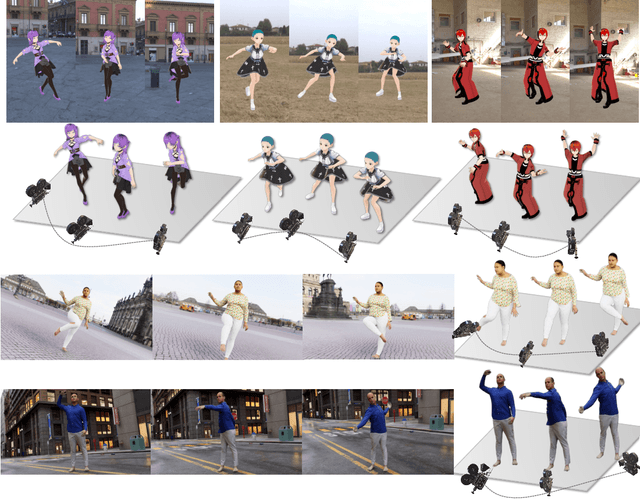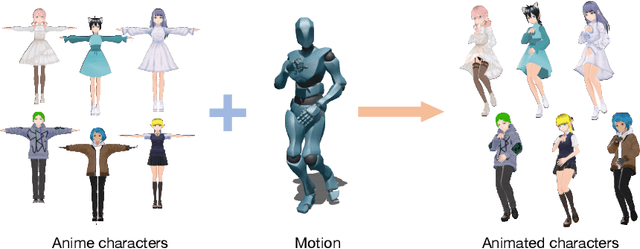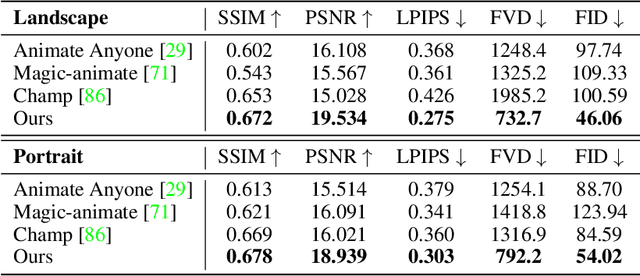Youqing Fang
HumanVid: Demystifying Training Data for Camera-controllable Human Image Animation
Jul 28, 2024



Abstract:Human image animation involves generating videos from a character photo, allowing user control and unlocking potential for video and movie production. While recent approaches yield impressive results using high-quality training data, the inaccessibility of these datasets hampers fair and transparent benchmarking. Moreover, these approaches prioritize 2D human motion and overlook the significance of camera motions in videos, leading to limited control and unstable video generation. To demystify the training data, we present HumanVid, the first large-scale high-quality dataset tailored for human image animation, which combines crafted real-world and synthetic data. For the real-world data, we compile a vast collection of copyright-free real-world videos from the internet. Through a carefully designed rule-based filtering strategy, we ensure the inclusion of high-quality videos, resulting in a collection of 20K human-centric videos in 1080P resolution. Human and camera motion annotation is accomplished using a 2D pose estimator and a SLAM-based method. For the synthetic data, we gather 2,300 copyright-free 3D avatar assets to augment existing available 3D assets. Notably, we introduce a rule-based camera trajectory generation method, enabling the synthetic pipeline to incorporate diverse and precise camera motion annotation, which can rarely be found in real-world data. To verify the effectiveness of HumanVid, we establish a baseline model named CamAnimate, short for Camera-controllable Human Animation, that considers both human and camera motions as conditions. Through extensive experimentation, we demonstrate that such simple baseline training on our HumanVid achieves state-of-the-art performance in controlling both human pose and camera motions, setting a new benchmark. Code and data will be publicly available at https://github.com/zhenzhiwang/HumanVid/.
Sagiri: Low Dynamic Range Image Enhancement with Generative Diffusion Prior
Jun 13, 2024Abstract:Capturing High Dynamic Range (HDR) scenery using 8-bit cameras often suffers from over-/underexposure, loss of fine details due to low bit-depth compression, skewed color distributions, and strong noise in dark areas. Traditional LDR image enhancement methods primarily focus on color mapping, which enhances the visual representation by expanding the image's color range and adjusting the brightness. However, these approaches fail to effectively restore content in dynamic range extremes, which are regions with pixel values close to 0 or 255. To address the full scope of challenges in HDR imaging and surpass the limitations of current models, we propose a novel two-stage approach. The first stage maps the color and brightness to an appropriate range while keeping the existing details, and the second stage utilizes a diffusion prior to generate content in dynamic range extremes lost during capture. This generative refinement module can also be used as a plug-and-play module to enhance and complement existing LDR enhancement models. The proposed method markedly improves the quality and details of LDR images, demonstrating superior performance through rigorous experimental validation. The project page is at https://sagiri0208.github.io
PIA: Your Personalized Image Animator via Plug-and-Play Modules in Text-to-Image Models
Dec 21, 2023Abstract:Recent advancements in personalized text-to-image (T2I) models have revolutionized content creation, empowering non-experts to generate stunning images with unique styles. While promising, adding realistic motions into these personalized images by text poses significant challenges in preserving distinct styles, high-fidelity details, and achieving motion controllability by text. In this paper, we present PIA, a Personalized Image Animator that excels in aligning with condition images, achieving motion controllability by text, and the compatibility with various personalized T2I models without specific tuning. To achieve these goals, PIA builds upon a base T2I model with well-trained temporal alignment layers, allowing for the seamless transformation of any personalized T2I model into an image animation model. A key component of PIA is the introduction of the condition module, which utilizes the condition frame and inter-frame affinity as input to transfer appearance information guided by the affinity hint for individual frame synthesis in the latent space. This design mitigates the challenges of appearance-related image alignment within and allows for a stronger focus on aligning with motion-related guidance.
 Add to Chrome
Add to Chrome Add to Firefox
Add to Firefox Add to Edge
Add to Edge